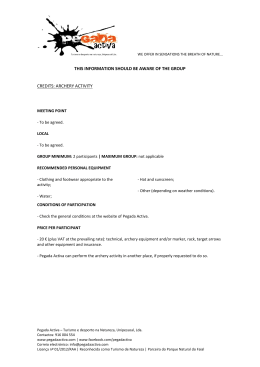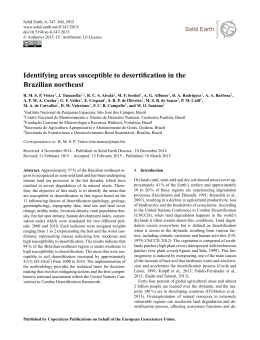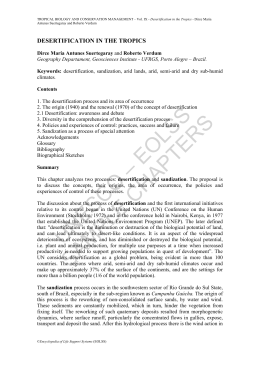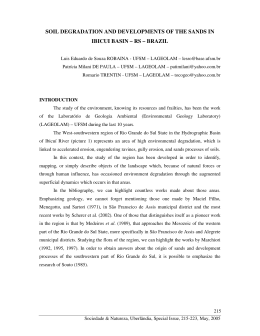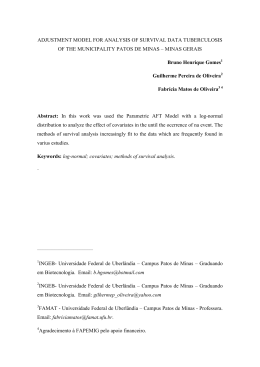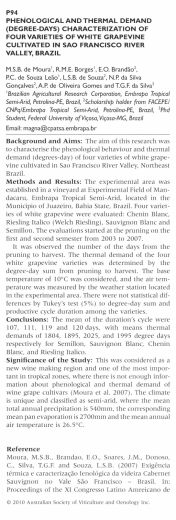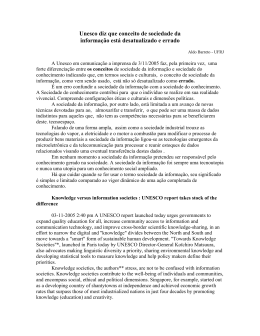Sociedade & Natureza ISSN: 0103-1570 [email protected] Universidade Federal de Uberlândia Brasil Rabêlo Cavalcanti, Edneida; Fernandes Soares Coutinho, Solange DESERTIFICATION IN THE NORTHEAST OF BRAZIL: THE NATURAL RESOURCES USE AND THE LAND DEGRADATION Sociedade & Natureza, vol. 1, núm. 1, mayo, 2005, pp. 891-900 Universidade Federal de Uberlândia Uberlândia, Minas Gerais, Brasil Available in: http://www.redalyc.org/articulo.oa?id=321328500086 How to cite Complete issue More information about this article Journal's homepage in redalyc.org Scientific Information System Network of Scientific Journals from Latin America, the Caribbean, Spain and Portugal Non-profit academic project, developed under the open access initiative DESERTIFICATION IN THE NORTHEAST OF BRAZIL: THE NATURAL RESOURCES USE AND THE LAND DEGRADATION Edneida Rabêlo Cavalcanti Joaquim Nabuco Foundation and Nucleus of Environmental Administration NGA/FCAP/UPE E-mail: [email protected] Solange Fernandes Soares Coutinho Foundation Joaquim Nabuco and University of Pernambuco/UPE E-mail: [email protected] ABSTRACT The Agenda 21 and the United Nations Convention for Desertification Combat defines desertification as the degradation of lands in arid regions, semi-arid and sub-wet dried, resulting from various factors, among them the weather variations and the human activities. This understanding, besides marking the geographical space to be taken into consideration, undoes with the clearly climatic view of the question and proves that desertification has its origin in complex interactions of physical factors, biologics, political, socials, cultural and economics. However, it’s necessary to recognize that there are generally more serious causes, as the poverty, that leaves no alternative for the husbandmen only get from land the maximum possible to supply the family’s immediate necessity even affecting its subsistence for a long time. In terms of world, semi-arid regions represent 1/3 of the planet's surface, where lives 1/5 of the population, more than 1 million people. Twenty-two per cent is the participation of these areas in the production of foods. The Semi-arid of Brazil is registered as one of the physiographic zones of the Northeast Region, representing about 57% of this territory. The organization of the economical process, historically based on extensive cattle breeding and agriculture, and on the existence of some products of larger importance in the market, like the case of cotton was, always based on an agrarian structure dominated by land concentrations. In the more diffused desertification process in the North-eastern semi-arid this pattern has been constructed on alarming proportions, aggravated and reaffirmed by the occurrence of periodic droughts and the peculiarities due to the systems of production that appear from this process directly contrary to the correct manners of use of the natural resources, in option to, where and how to develop the agricultural activities. 891 Sociedade & Natureza, Uberlândia, Special Issue, 891-900, May, 2005 Key Words: Semi-arid of Brazil; Desertification; Usage Natural of Resources. INITIAL COMMENTS The present work deals with the phenomenon of the desertification in the Brazilian semi-arid, aiming to discuss it at the light of the occupation process and use of the lands, in the context of a country firstly inhabited for indigenous populations, whose survival depended on their integration to the environment, but later passed to the situation of colony of exploration, what contributed to the formation of a social nation and economically differentiated, where its semi-arid portion and also sub-humid dried is until today understood as an area-problem, where the public politics predominantly act in punctual way, disconnected, generating uses and predatory handlings that gives condition to the installation of the desertification process. The that approach adds the one of treating the theme of the desertification also for the analysis of the environmental risk, in a social perspective, whose interpretation is centred in the idea that the risk only exists for the conjugation of risk factors (that can have natural causes, but that in general are provoked by the human action) and more the level of vulnerability of the populations, that depends directly on aspects socio-economic, cultural and political. The word desertification is giving margin to several interpretations and some misleading, mainly those that relate the term to a process of creation of deserts. Of the formal point of view, however, that controversy was solved when of the approval of the document of the Agenda 21 and of the Combat to Desertification Convention and the Effects of the Drought. CCD, goes the United Nations. In agreement with CCD, the desertification is understood as “the degradation of the lands in the arid areas, semi-arid and subhumid dried, resultants of several factors, among them the climatic variations and the human activities and for degradation of the lands understands it as the degradation of the soils, of the water resources, of the vegetation and the reduction of the quality of life of the affected populations." 892 Sociedade & Natureza, Uberlândia, Special Issue, 891-900, May, 2005 But the definition raises new questions and one of them, according to Sampaio; Sampaio (2002, p.26) it is that" the desertification is a dynamic process, with a chain of events, frequently closed in vicious cycles. Like this, some events can be the initial cause of the process, but they give place to consequences that can feed the original causes." Another group of points that hinder the understanding of the subject concerns to the associations done between desertification and drought, going from those that believe it is a single phenomenon, the ones that consider that the desertification can take to an increase or intensification of the drought and, according to Matallo (2001, p. 29), "finally, there are those that think the desertification doesn't pass of a myth, originated of the process of temporary expansion of Sahara, or even an invention to capture funds of the developed countries". It is correct that the drought is an event bounded in the time and we can say that even previsible, besides there have already been registrations and studies with temporary series of significant periods. For its time, the desertification is a process, which can be generated including in the called "good years" (those without drought) and in that way are not immediately evident. All those reasons converge to accentuate the understanding difficulties and visualization of the desertification, as well as its dimension as a problem really important to be faced. Besides, it has been enough discussed the absence of methods of studies universally accepted. The one that seems exist is a group of knowledge of different areas that is put to service of the understanding of the problem of the desertification, if not constituting in method, in the classic sense of the term. In agreement with Matallo (op. cit., p.27): "an evaluation of the theoretical production on desertification shows the plurality of methods and systems of indicators used all over the world, what reveals the difficulty in establishing a consensus on a basic system of investigation on the phenomenon, that considers the multiplicity of aspects contained in itself". That hinders to do estimates on the extension of the problem, because in some cases what it is computing is just the degradation of the soil, that can take you to underestimated value, or for its time the degradation of the vegetation is being included, that can be reverted, and like 893 Sociedade & Natureza, Uberlândia, Special Issue, 891-900, May, 2005 this to generate overestimated data. The United Nations Program for the Environment – UNPE - affirms that 36 million Km2 of the ecosystems of dry lands, being included the hipper-arid environment, presents some types of degradation. It is a high extension, that is not being braked and those influences negatively on the survival condition of great population contingents. It is possible to affirm that in environmental terms, the main process related with the degradation of the called dry lands (arid areas, semi-arid and sub-humid dried, mark of the CCD application) it is the desertification´s one. In agreement with Wolf; Gutiérrez (2003, p.31)," its nature and its causes are private in each specific situation, and it depends on the characteristics of the natural ecosystem and on the history of the uses of the soil in each area." DESERTIFICATION IN BRAZIL The pioneering studies are attributed to the botanist Vasconcelos Sobrinho during the 70s and with intensification due to Brazilian participation, through of that professional in the International Conference on Desertification happened in Nairobi, in 1977. Brazil also participates actively of the preparatory discussions to the Convention on Environment and Human Development – CEHD -, in what concerns the theme, being the organizer of a specific event. In Brazil, the semi-arid space has been discussed and extended for several authors. Carvalho (1988), Coelho (1988) and Guimarães Filho et al (1995) calculated different areas for the semi-arid area. Carvalho's proposal, that points to be of 882.081Km2 the semi-arid domain, has got as advantage, in the point of view of the public planning, to join Homogeneous Microregions. That regionalization passes to be adopted by the Superintendence of the Development of the Northeast. Sudene., to the ends of activity of the Northeast Constitutional Fund of Financing - FNE. In the point of view of the application mark of CCD, it should be included the semi-arid areas and sub-humid dried that in Brazil make part the territorial portions of the States of Piauí, Ceará, Rio Grande do Norte, Paraíba, Pernambuco, Alagoas, Sergipe, Bahia and Minas Gerais and, in agreement with the National Plan of Action – PAN (2004), elaborated starting from 894 Sociedade & Natureza, Uberlândia, Special Issue, 891-900, May, 2005 the Ministry of the Environment - MMA -, " those spaces include the surface of 1.130.790,53 Km 2, from which 710.437,30Km2 (62,83% of the total) are known as semi-arid and 420.258,80 Km 2 (37,17% of total the) as sub-humid dried". However, that same document enlarges the susceptible area to the desertification for enclosing what they call as surrounding areas of the semi-arid and sub-humid dried, partly for they belong to the biome caatinga, and in the case of the municipal districts of the State of Espírito Santo according to the Law 9.690/1998, that disposes about the inclusion of the valley of Jequitinhonha in the State of Minas Gerais and municipal districts of the North Area of Espírito Santo in the Sudene´s performance area. That attitude exemplifies the dynamic that exists in the discussions about the theme and the solutions found to contemplate different technical approaches, but also political aspects, because in the last case, those delimitations are the base to re-pass resources, being them federal or even international. Our conception, agreeing with the conceptual imprecision and indicators, is based on what CCD says and we are referring like this to the semi-arid areas and sub-humid dried; giving evidence to the semi-arid portion, because of its extension and for its largest socioenvironmental fragility. For Magalhães (1995, p.233), "concerning the environmental subject, the continuous land productivity loss, the exhaustion of natural resources not renewed and the decrease of the deposits of underground water are indicative of unsustainability. The desertification processes in several more vulnerable areas reflect the conditions of unsustainable use of the soils, of the vegetation, of the water resources and of the biodiversity." At his time, affirms (Castro, 1996, p. 297): "the specificities of the semi-arid ecosystem made possible an occupation way and a system of agents that did, together, a very particular space. This 895 Sociedade & Natureza, Uberlândia, Special Issue, 891-900, May, 2005 space has been presented historically by the filter of a collective understanding of the difficulties imposed by this environment, that depends on the climatic bad luck. The nature there is a being almost metaphysician, it is strongly idealized and worked in its speeches and about the region, as an insurmountable obstacle to any progress or social justice." However, it is important to appeal to the environmental history of that part of Brazil to understand all that our problems from now were built historically and as the process of socioeconomic occupation was done to the detriment of the capacity of resilience of the ecosystems present there. The deforestation is one of the most visible actions of the degradation process. Besides committing the biodiversity, leave the soils uncovered and exposed to the erosion and it happens as a result of the economic activities, being for dry lands agriculture or irrigated, or cattle rearing, when the native vegetation is substituted by pasture, being directly for the use of the wood as source of energy (firewood and coal). There are already discussions and important experiences that offer other possibilities for the sustainable use of the vegetation of the caatinga. The intensive use of the soil, without break and without conservation techniques, causes erosion and commits the productivity, directly repercuss in the farmer's economic situation. Every year, the crop decreases, and also the possibility to have food reservations for the drought period. It is common to verify, in the semi-arid, the activity of the livestock to be developed without considering the capacity of support of the area, what presses as much the native pasture as planted, besides turning the soil hardened, compact. For its time, the badly irrigation cause the saltlization of the soils, making unfeasible some areas and putting in risk several public investments. In the irrigated perimeters of the semiarid, the problem has been caused as by the irrigation type, a lot of times inadequate to the characteristics of the soil, as, and mainly, for the way how the activity is executed, making "watering" instead of irrigation. 896 Sociedade & Natureza, Uberlândia, Special Issue, 891-900, May, 2005 Besides they are correlated, those problems unchain other, of extreme gravity for the region. It is the case of the lower of the watercourses and reservoirs caused by the erosion unchained by the deforestation and for economic activities developed without cares with the environment. Concerning to the erosion, the data regarding to the semi-arid tropic are little detailed. The unit of soils of Embrapa is working in the elaboration of an erosion map for the region, but the estimates can already be built with base in the human effects level and their correlations with other elements. The human effects concept sends, in general lines, to the idea of "modification of the landscape", could go from areas completely devastated to those that are slightly impacted. Studies accomplished by IBGE/Ibama/Sudene, starting from risings accomplished in 1989 and in 1994, they point that in the period there was a progress of the human effects of 34,25% for 53%. That average can, also, be extrapolated for the semi-arid. For its time, the soils of that portion of the Brazilian territory are, predominantly, formed by Bruno non calcium 38%) and Litolics (10%), whose pre-disposition to the erosion is accentuated. Matallo (2000) elaborates, based in those data, some hypotheses to propose losses estimate to the erosion. He considers, for instance, that 65% of the semi-arid affected area are busy by agricultural activities into the sustainable handling patterns and, therefore, with minimum levels of erosion and that in the other ones 35% there would be accentuated erosion, around 10% above the average. With such general considerations the author points that the total of annual physical loss would be of 650.550.000 tons. The impacts of the process, however, don't stop thereabout, because that great amount of soil lost will destine to the hydrographical basins, lowing the gutters of the rivers, the dams and reservoirs, committing the storage capacity of the water resources. Still according to the same author, following the idea that each ton of eroded soil contributed to decrease in 20% of the storage capacity and retention of water, we would have a total of loss water of 130.110.000 m3. Those numbers send for the perspective of thinking the desertification to the light of the risk analysis. If by definition every arid area, semi-arid and sub-humid dried is vulnerable to the process, it is also true that the vulnerability degree varies in agreement with characteristics 897 Sociedade & Natureza, Uberlândia, Special Issue, 891-900, May, 2005 socioenvironmetal. Besides, the threats that compose the equation also possess differentiated origins, going from the occurrence of a drought, until, and in a more permanent way, the whole process of socio-economic organization, that goes in the productive processes of use of the natural resources. FINAL CONSIDERATIONS The desertification stage in Brazil points to a reflection about the daily construction of the problem in local scale, in other words, it is through the socio-spatial organization process, of the productive systems, of the relationships production existent, of the public politics perspective adopted, that historically has been delineated the intense degradation of the semiarid areas and sub-humid dried. Understanding the perception of the several social subjects on the theme of the desertification constitutes an important step in the perspective of plan constructions, programs and projects seeking to control the problem. It is in that perception space that the practices can be modified in a structural and permanent way, through the effective participation of the social subjects. The environmental aspects can not to, in that way, be treated in an isolated way, even for the fact that the desertification has its origin in complex and interdependent factors and no matter how much its necessary to go deeper into a certain themes, those should not lose of view a systemic analysis. In spite of the progresses, mainly in a larger attention given by professionals and government and no-government institutions to the theme, as well as of the initiatives of the public power and/or organized civil association, still punctual and sectorial actions prevail. For its time, the discussions contained in that work point to the need of more articulate politics, once that the phenomenon is so much complex as in their causes as in their consequences. It appears, in a lot of situations, the approach of the problem for a hydric slope, even not in an explicit way, taking to propositions of technological nature - important, but not enough to effective changes and based in the responsible participation of the different social subjects involved. An approach starting from the environmental management, while mediation of interests and conflicts in the use of the natural resources blunts as a way to go along. 898 Sociedade & Natureza, Uberlândia, Special Issue, 891-900, May, 2005 BIBLIOGRAPHICAL REFERENCES AND BIBLIOGRAPHY BRASIL. Ministério do Meio Ambiente, dos Recursos Hídricos e da Amazônia Legal. Diretrizes para a Política Nacional de Controle da Desertificação – Projeto BRA 93/036/ Plano Nacional de Combate à Desertificação. Brasília: MMA, 1998. _______. Ministério do Meio Ambiente, dos Recursos Hídricos e da Amazônia Legal. Desertificação: caracterização e impactos. Brasília: MMA, 1993. (Projeto BRA 93/036 – Elaboração de uma Estratégia e do Plano Nacional de Combate à Desertificação). _______. Ministério do Meio Ambiente. Programa de Ação Nacional de Combate à Desertificação e Mitigação dos Efeitos da Seca PAN-Brasil. www.mma.gov.br. Capturado em 14/03/05 CAMPELLO, Francisco Barreto et al. Diagnóstico florestal da Região Nordeste. Brasília: Ibama CARVALHO, Otamar de. A economia política do Nordeste – secas irrigação e desenvolvimento. Rio de Janeiro: Editora Campos, 1988. CASTRO. Iná Elias de. Seca versus seca. Novos interesses, novos territórios, novos discursos no Nordeste. In: CASTRO, Iná Elias de; GOMES, Paulo César da Costa; CORRÊA, Roberto Lobato. (orgs). Brasil: questões atuais da reorganização do território Rio de Janeiro: Bertrand Brasil, 1996. CAVALCANTI, Edneida Rabelo; COUTINHO, Solange Fernandes Soares; LIMA, Maria José de Araújo. Desertificação no Brasil: uma visão integrada na perspectiva da gestão ambiental. In: Anais do VII Congreso Internacional de Geografía de América Latina. Madri: Universidad Complutense de Madrid, 2004. (CD-ROM) CAVALCANTI, Edneida Rabêlo; MORGADO, Tereza. Desertificação e gênero: uma abordagem necessária. In: SCHENKEL, Celso Salatino; MATALLO JUNIOR, Heitor (org.). Desertificação. Brasília: UNESCO, 1999. GOMES, Alfredo Macedo. Imaginário social da seca, suas implicações para a mudança social. Recife: FUNDAJ, Editora Massangana, 1998. 226p. LAYRARGUES, Philippe P. Educação para gestão ambiental. In: LOUREIRO, Carlos F. B.; LAYRARGUES, Philippe P.; CASTRO, Ronaldo Souza de (orgs.). Sociedade e meio ambiente: a educação ambiental em debate. São Paulo: Cortez, 2000. 899 Sociedade & Natureza, Uberlândia, Special Issue, 891-900, May, 2005 LOBO, Montserrat Blanco; GUTIÉRREZ, Margarita Veláquez. De aciertos y desiertos: equidad de género en ecosistemas de tierras secas. San José, C.R.: Editorial Absoluto, 2003. MAGALHÃES, Antônio R.. Um estudo de desenvolvimento sustentável do nordeste semiárido. In: CAVALCANTI, Clóvis (org.). Desenvolvimento e natureza: estudos para uma sociedade sustentável. São Paulo: Cortez; Recife, PE: Fundação Joaquim Nabuco, 1995. MATALLO JÚNIOR, Heitor. Desertificação e sustentabilidade no semi-árido. Revista ECO 21. Rio de Janeiro. p.40-44. Mar/Abr, 2000. MATALLO JÚNIOR, Heitor. Indicadores de desertificação: histórico e perspectiva. Brasília: UNESCO, 2001. OND. Indicators for assessing desertification in the Mediterranean. Italy: Porto Torres, 1998. PERNAMBUCO. Secretaria de Ciência, Tecnologia e Meio Ambiente. Política Estadual de Controle da Desertificação. Recife: Sectma, 1999. RODRIGUES, Valdemar et.al. Avaliação do quadro de desertificação no Nordeste do Brasil: diagnóstico e perspectiva. In: GOMES, G. M. et. al. Desenvolvimento Sustentável no Nordeste. IPEA: Brasília, 1995. RODRIGUES, Valdemar. Pesquisa dos estudos e dados sobre desertificação no Brasil. Plano Nacional de Combate à Desertificação. Brasília: Ministério do Meio Ambiente, 1997. SAMPAIO, Everardo; SAMPAIO, Yony. Desertificação: conceitos, causas, conseqüências e mensuração. Recife: Editora Universitária UFPE, 2002. SCHENKEL, Celso Salatino; MATALLO JUNIOR, Heitor (org.). Desertificação. Brasília: Unesco, 1999. SELVA, Vanice Santiago Fragoso. Desertificação: uma leitura dos impactos sócioambientais. Recife, 2001 (Digitado). VASCONCELOS SOBRINHO, João. Processos de desertificação no Nordeste. Sudene: Recife, 1983. _______. O grande deserto brasileiro. Recife: SUDENE, 1974. _______.Núcleos de desertificação no polígono das secas. In: Anais do ICB 1. Universidade Federal de Pernambuco. Recife: UFPE, 1971. 900 Sociedade & Natureza, Uberlândia, Special Issue, 891-900, May, 2005
Download
